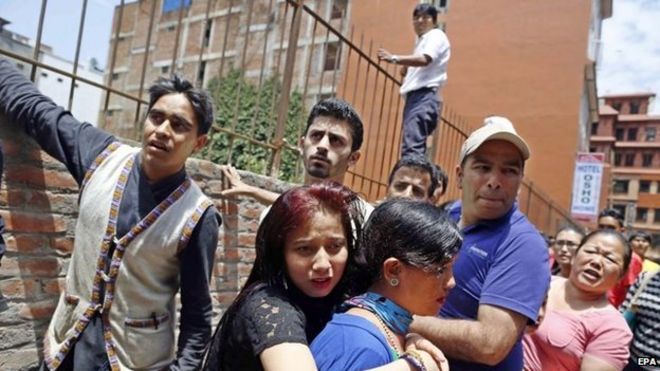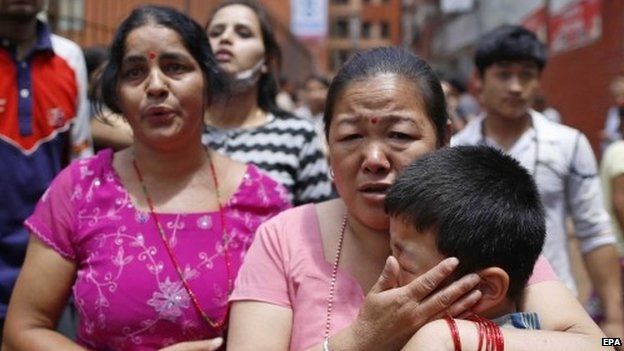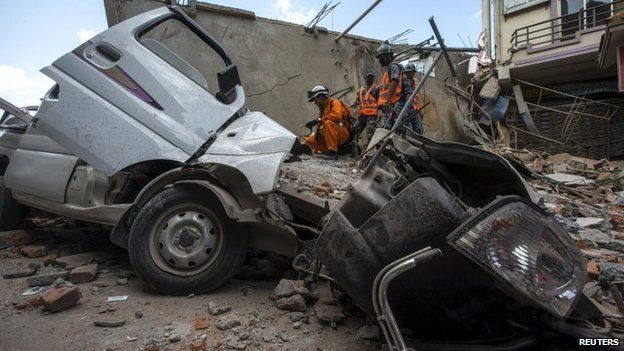
A major earthquake has struck eastern Nepal, near Mount Everest, two weeks after more than 8,000 died in a devastating quake.
At least 16 people have been killed and 846 injured, according to Nepal's information minister.
The latest earthquake hit near the town of Namche Bazaar, near Mount Everest.
The US Geological Survey said it had a magnitude of 7.3. An earthquake on 25 April, centred in western Nepal, had a magnitude of 7.8.
Read also: Andover girl is youngest US female chess master
The latest tremor was also felt in northern India and Bangladesh.
F ollow the latest developments on our live page
In the Nepalese capital Kathmandu, which was badly damaged last month, people rushed out of buildings as the quake struck at 12:35 local time (06:50 GMT).
Rescue helicopters have been sent to districts north-east of the capital, that are believed to be worst affected.
At the scene: Simon Cox, BBC, Kathmandu
You could feel it really strongly. It went on for about 25 seconds - the ground was shaking, the birds started squawking, you could feel the buildings shaking.There was another aftershock and people were all out on the street. That aftershock really added anxiety and panic. People started crying.
They are calm but you can tell they are all scared.
Read also: Ukraine crisis: John Kerry to meet Putin in Russia
he BBC's Yogita Limaye, who was in Nepal's mountains when the latest earthquake struck, said: "The earth shook and it shook for a pretty long time.
"I can completely understand the sense of panic. We have been seeing tremors: it's been two-and-a-half weeks since the first quake. But this one really felt like it went on for a really long time. People have been terrified."


At least four people were killed in the town of Chautara, east of the capital, Kathmandu, where a number of buildings are reported to have collapsed.
The International Organisation for Migration said bodies were being pulled from rubble there.
Krishna Gyawali, the chief district officer for Chautara, said there had been a number of landslides.

The epicentre of the latest earthquake was 83km (52 miles) east of Kathmandu, in a rural area close to the Chinese border.
It struck at a depth of 15km (9.3 miles), according to the US Geological Survey - the same depth as the April 25 quake. Shallow earthquakes are more likely to cause more damage at the surface.
Tuesday's earthquake is likely to be one of the largest to hit Nepal, which has suffered hundreds of aftershocks since 25 April.
The 7.3 quake was followed by six aftershocks of magnitude 5.0 or higher.
One tremor that hit 30 minutes later, centred on the district of Ramechhap, east of Kathmandu, had a magnitude of 6.3.
You need to install Flash Player to play this content.
Analysis: Jonathan Amos, BBC News, Science Correspondent
By any stretch, a magnitude-7.3 quake is a big one. It's not quite as big as the quake on 25 April (7.8), which was 5.5 times more energetic, but it's a major tremor nonetheless.Since 25 April, the immediate analysis had suggested that more activity on the fault was possible because the previous event had not ruptured all the way to the surface. That meant some of the strain built up in the rocks over the years had not all been released.
One has to hope that the buildings which were damaged last time have been felled in subsequent aftershocks, or have been put out of bounds. This will limit the casualties this time. But further landslides and avalanches in the mountainous terrain are a persistent risk.
And, of course, another big tremor does nothing for the frayed nerves of an already anxious population.
http://www.bbc.com
No comments:
Post a Comment